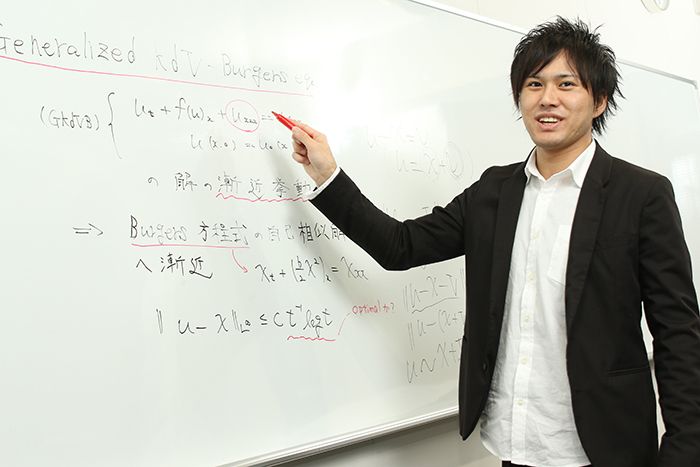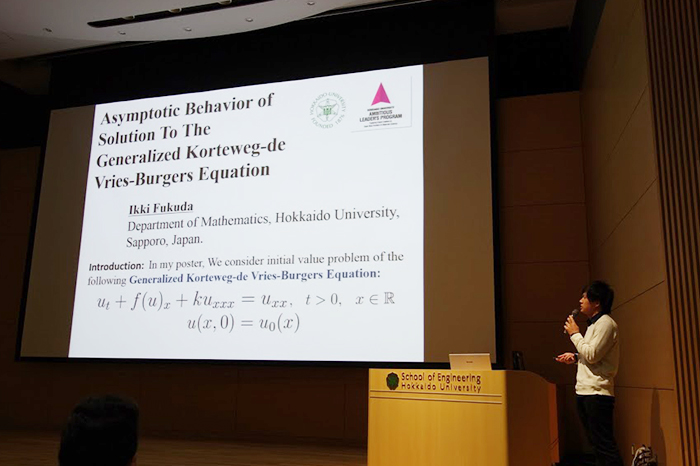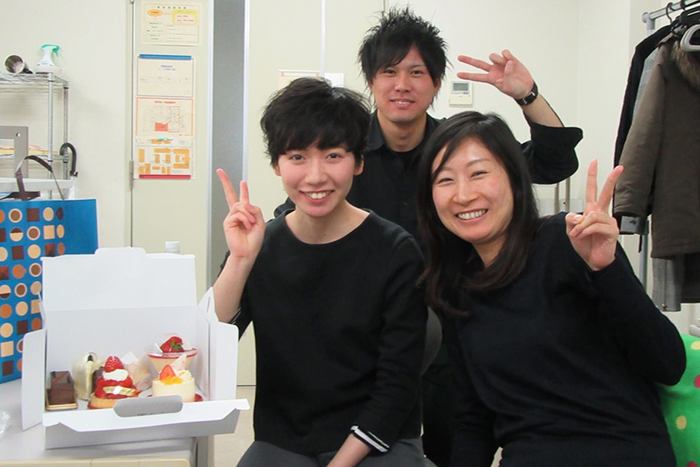
Hokkaido University Graduate School of Science, Department of Mathematics, Kubo Laboratory
Master’s Course, Second Year
Ikki Fukuda
—————
Specialized Research
My research theme is nonlinear partial differential equation theory. I am researching to determine the behavior exhibited over time by solutions to equations of conservation laws, which describe wave movements that are observable in fluid dynamics.
●My Path for Taking the Course 1
I Went to Hokkaido University to Devote Myself to Mathematical Research.
I Was Stimulated by the Activities of the Program Students.
As I originally wanted to teach mathematics, I enrolled in the Niigata University Faculty of Education to major in mathematics education. However, when I began to increasingly feel that I wanted to learn mathematics for myself more than I did for teaching other people, I decided to change my path. A teacher with whom I consulted recommended that I visit Hokkaido University, and I was drawn to the enhanced research environment of the graduate school, for instance, the mathematics library and the graduate student offices. I entered the Kubo Laboratory, to which I currently belong.
When I did not meet the criteria for taking the entrance examination or the timing requirements for the first year of the Master’s Degree Program, I temporarily gave the entrance examination for the Leading Program a pass. However, I went to the International Symposium planned by the Leading Program and to the Joint Symposium with Seoul University as an independent participant, where I witnessed the high caliber of the program students who were managing these symposiums. My desire to take the course strengthened once again.

Experiencing a poster review at the International Symposium after enrolling in the Leading Program.
●My Path for Taking the Course 2
Sharing a Win-Win Relationship With Interdisciplinary Lab Visit Students.
The germ of the idea that I do have interests in different fields began taking root once I began learning at Hokkaido University. Students of mathematics often tend to overlook physical phenomena in their research themes’ background and concentrate only on mathematics. Is that really the right way of going about mathematical research?
As I began to question such mathematical research, the Kubo Laboratory started accepting Interdisciplinary Lab Visit students specializing in pharmaceutical science at the Graduate School of Life Science. We all mutually acquired fresh knowledge in pharmaceutical science and mathematics while we bolstered each other’s research. During these activities, I heard directly about the prestige associated with the Leading Program, and this propelled me toward taking the entrance examination for a transfer into the program.

Celebrating an Interdisciplinary Lab Visit student’s birthday with a cake. Voices of the program students got me to spring into action.
●Deeply Impressive Curriculum
Solving Challenges in Materials Science with Mathematics.
Forging Comprehensive Perspectives that Look at Surrounding Areas.
To secure a transfer from the second-year Master’s Degree Program, you must pass the mid-term examination QE1 that the program students also take. The research subjects that are considered are of two types: “cross-disciplinary” and “integrating mathematics and science.” I chose the latter. I proposed research to address molecular motors that are responsible for transporting substances in vivo and collective movements of kinesin using mathematical models. I was then accepted as a transfer student.
In the required course, Frontier Mathematical Sciences III, I reviewed and explained my research content through mathematical perspectives so that students and instructors in different fields could understand them. I am forging “comprehensive perspectives” that investigate peripheral fields through a series of cross-field lessons.
●My Target Future Image
My Goal is to Become a Versatile Mathematical Researcher,
A Leader Who can Contribute.
I have only just begun interdisciplinary studies; however, I know that my opposition to interdisciplinary studies has become considerably weaker since I became a program student. In the future, I also want to try being a prime mover, planning cross-border events. I also look forward to managing the International Symposium soon.
To continue with mathematics, I think I would like to be grounded in academia, becoming a researcher who is well versed in various fields, while leveraging robust professional abilities as one axis. Now, I am sprouting the many branches of interdisciplinary studies from the big trunk that is mathematics! At the same time, in terms of leadership, I would like to acquire the ability to contribute with initiative and volition when I, or those around me, think of something to do.

